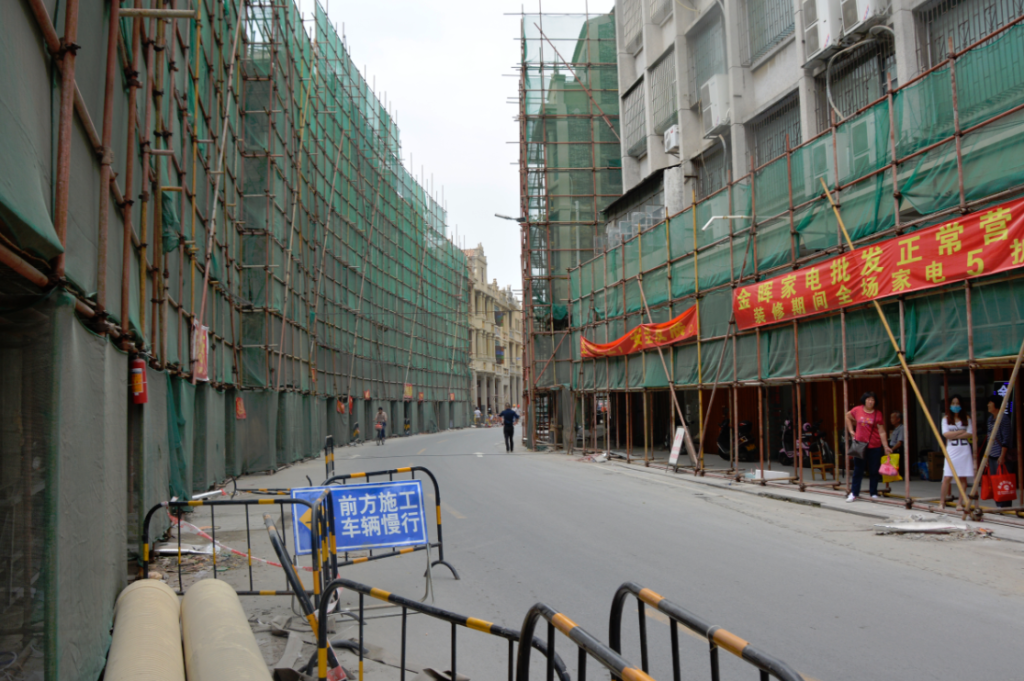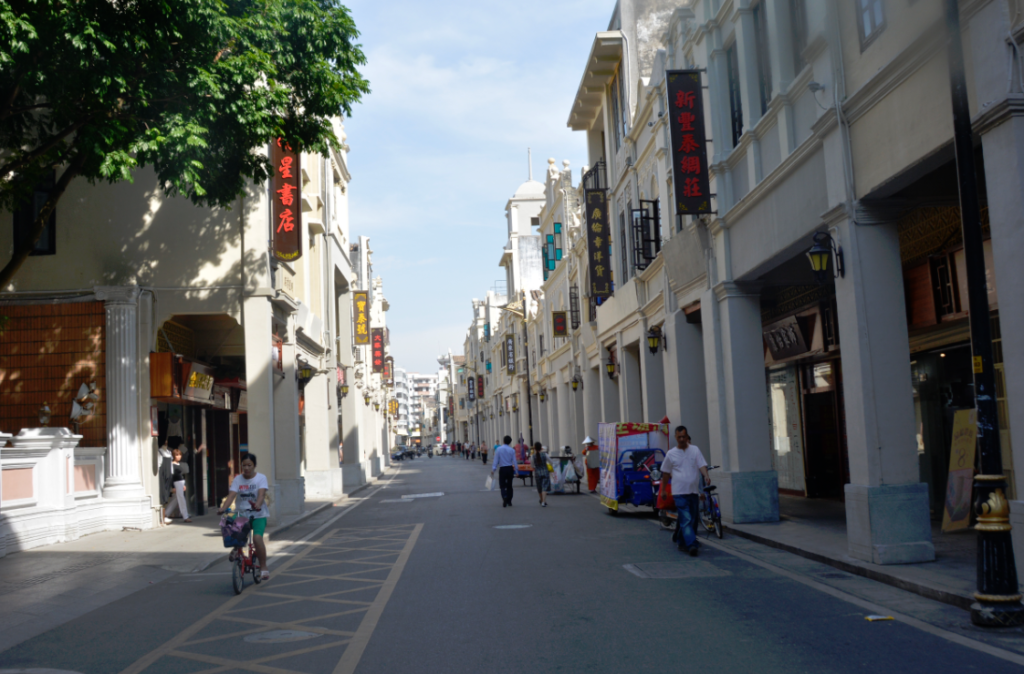
A revolution is taking place in Taishan, Guangdong, China.
Taishan’s Taicheng district’s Old Town is being remodeled brick by brick back to the 1880’s. They are tearing apart their wiring, cables, wifi, and plumbing and putting them behind walls, hiding them in the ground, or covering them up with a façade, making them invisible. With this remodel Taishan is hoping to attract descendants from abroad.
Taishan is about a hundred miles west of Hong Kong. Its emigration started in 1840 in the midst of the 1st Opium war. The California Gold Rush of 1849 attracted more emigrates. When Hom Kun Foo, my maternal great-grandfather, born in 1838, left for the United States in 1851, (along with other Taishan immigrants) Taishan was poor, stricken with famine and floods, and men were drafted into the Tai Ping rebellion.
When the 2nd Opium War occurred it exacerbated Taishanese fleeing to Macau and Hong Kong as well as America. America offered relative security and salvation with jobs like the railroad, farming, and laundry. With these jobs, immigrants including Hom would send money home to support their families. Guangdong, with its foreign contacts in Macau and Hong Kong, sent thousands of sojourners, the majority being Taishanese out to the world despite being a different race.
While racism against the Chinese was prevalent in America it didn’t keep the Chinese out. Finally, the Chinese Exclusion Act of 1882 slowed the flow of Chinese to America to a trickle. By this time nascent Chinatowns had already formed. Hom help establish a Chinatown in Marysville, CA.; all his children were born there. Although some Chinatowns died like Marysville, others thrived in cities like Los Angeles, New York, and San Francisco.
After WWII, Chinese migration increased after the repeal of the Chinese Exclusion Act on 1943, the War Brides act of Dec 1945 and the Communist successful revolution of China in 1949. By 1965, Chinese in America 95% were Cantonese speakers (less than 3% in China) and more than half of the Chinese came from or descended from Taishan, according to Chinese American historian Him Mark Lai. Outside of China there are 1.5 million Chinese of Taishan descendants or migrants. In the late 1980’s, Chinese emigration slow down with the opening of Special Economic Zones (SEZ).
Before the opening in 1980 of China’s four SEZ, which allow for foreign investments, remissions were an important part of Taishan’s economy; most Chinese immigrants were diligent about sending money home. Hom sent money home until he retired. In 1910 he returned to Taishan and built four buildings. He died there in 1923. (His sons and daughters remained in America.) Remissions were especially important during China’s ‘Great Leap Forward,’ 1958-1962 when millions of people starved to death; and ‘Cultural Revolution,’ 1965-1969 when economic growth was near zero.
Now, with over 30 successful SEZ’s with the factories paying a decent wage most Chinese along the East coast are comfortable. Remissions are useful but not needed. Additionally, the third-generation Chinese Americans do not have direct ties to the Chinese in China so they do not send money. My mother, her brothers and sisters did not send money. And Taishan is doing well in this modern society.

In this modern society, there are a lot of infrastructure needs. At intersections, the red, blue, green and white electrical wires run to join transformers. Cable boxes with spare wire dangle from every building. Wifi, a must today, add their wires to the mix. White PVC pipes for water cling to walls. Water meters out front make meter reading easier but an eyesore. The gaudy advertisements mixed with balconies of drying clothes enter the lexicon of bad taste and discourages shoppers.
Hundreds of buildings scarred and ravaged by people and time must be remodeled. Thousands of water and electric meters must be moved. Dozens of blocks of sidewalks must be torn up to put down the pipes and wires. While the work is being done, miles of scaffolding have been erected and green mesh surrounds the buildings to protect passing pedestrians and vehicle traffic; they are rebuilding pillars pock marked like bullets holes and remaking second and third story buildings facades with dentils and crenelations.
When all is done the last vestiges of a modern society will disappear behind closed doors. When shops are closed, entire streets will have dark wooden shutters hiding the advertising and store fronts. Only the shop name will discreetly be visible above the door and sitting nearby will be white and green bins for collecting trash.
In a modern society, people generate tons of trash. The people of Taishan have had centuries of littering practice. They toss it in the street or put it on the curb. Hundreds of sweepers constantly go around picking up the detritus of lunch and dinner containers, plastic bags, receipts, handbills, and McDonald’s napkins. To combat this tendency, thousands of new green and white litter bins appeared on the streets; an advertising campaign against littering is in full force; and a war against littering has been declared. Still, breaking the littering habit is a problem and the sweepers are still out there collecting trash probably until the next century.
So here we are in the 21st century. Genealogy is doing a full court press in America. Senator Elizabeth Warren had her DNA tested to identify Native American blood; now all she needs to do is trace her roots. Tracing their roots for example were Irish, Japanese and just about anybody. The Chinese are no exception and they are getting help in finding their roots.
“This year we’ve helped over 3,000 Overseas Chinese who are seeking their roots.” According to He Zhi Heng, president of Xin Ning magazine, (the magazine is written for and distributed to Chinese in 92 countries), he said. “In addition we had 60,000 visitors during the week-long celebration of the founding of the People Republic of China. Weekly, we have six tour buses of people from Macau and Hong Kong come to Taicheng and stay overnight. This is not counting the Overseas Chinese who come back who don’t need our help.”

Paying attention to Overseas Chinese is a important. With remissions dwindling, Taishan must develop the tourism. They say 80% of the visitors see 20% of China. Taishan is not in the tourist track. Without these renovations, I think there is enough attractions like Taicheng with its museums, monuments, and great food, and Chuan islands, Chixi, and Longqi Wan with its great beaches. With this massive remodel from 2018 back to 1880, Taishan is letting them know what it was like when their antecedents left. Whether this is effective or not remains to be seen.
In today’s Taishan, with a population of 941,000 according to the 2010 census, there is more security, no shortage of food, and no rebellion. Anything that was not visible in the 1880’s will not be visible today, meaning cables, wires, and plumbing will be moved or hidden.
They finished in time for the 2019 Chinese New Year. Visitors to this revolution will find the new “Old Town” will look old and offer shopping in a pleasant environment, clean streets and beaches, and four and five star hotels with wifi, cable television, hot showers and indoor toilets.
More information on the Taishan Project can click here.
AsAmNews has Asian America in its heart. We’re an all-volunteer effort of dedicated staff and interns. Check out our Twitter feed and Facebook page for more content. Please consider interning, joining our staff or submitting a story


RE: China seeks to restore homeland of Many Chinese Americans:Genetically speaking, the Taishan are not of Han descent? True?
RE: China seeks to restore homeland of many Chinese Americans: Who says we aren’t Han Chinese? Never heard that at all.
RE: China seeks to restore homeland of many Chinese Americans: There are Northern Han and Southern Han. I think we are mostly Southern Han.
RE: China seeks to restore homeland of many Chinese Americans: We, Taishanese are 100% Han
RE:China seeks to restore homelands of many Chinese Americans: Wow. Thank you!! I want to go back. We are 7 generations in our family and really need to visit Taishan. So much to learn and root oneself with. I have written the story of my maternal line who started the fishing industry in Monterey and am now tackling my mom’s paternal side with the mystery of his death. He was very high profile ‘Prince of Merchantdom’ in Chicago. Lots of mystery! Reading of my story soon and more research next year might mean a trip to Taishan before the premiere of this story performance in 2020! Thank you again for this article.
RE: China seeks to restore homeland of many Chinese Americans: Very interesting article!
remissions => remittances
RE: China seeks to restore homeland of many Chinese Americans: I want to visit. What is the treatment of the diaspora that have lost the language?
RE: China seeks to restore homeland of many Chinese Americans: Thank-you for a great article. I learned a lot about my Taishan ancestral homeland and ancestors immigrated here in the 1800s. We need more articles like this
RE: China Seeks to Restore Homeland of Many Chinese Americans: My mom & I are going to Taishan (Hoipeng) in the fall of 2019. She hasn’t been back to her place of birth for 20+ years and where she grew up before leaving for Hong Kong then Canada. We’re both looking forward to it to see the changes, which I’m told is very modern and developed now. Can’t wait.
Taishanese and Cantonese people have traditionally referred to themselves as Tang people, not Han people. The area came into the Chinese empire during Tang dynasty, a good thousand years after the Han dynasty. The language is definitely Tang (try reading Tang poetry aloud in Cantonese or Taishanese and then in putonghua!) and again, traditionally their own term for Cantonese was Tangwa (Tang language). A good argument can certainly be made for Cantonese not being Han, but if someone wants to call it Southern Han, they’re welcome to use the terminology they prefer.
How is Tang and Han people defined? trying to understand the issue. Friend of mine from Beijing once referred to himself and me as being Han to caucasian friends. I’m confused. TIA.
Actually, Guangdong came under Chinese rule during the Qin dynasty (221-206 BC), although the region broke off during the fall of Qin and wouldn’t be under Chinese control again until the Han dynasty under Emperor Wu (r. 141-87 BC). The south was sparsely populated until the Song dynasty (960-1279 AD), when mass migration from the north occurred due to the loss of the much of the north to Jurchen invasion. The difference between Northern and Southern Han has always been exaggerated, as both possess the Haplogroup O2 has the dominant haplogroup. All Han Chinese are basically homogeneous when it comes to DNA from the paternal line, although there is some regional differences (not just north and south), when it comes to DNA from the maternal line. In short, we are definitely Han Chinese.